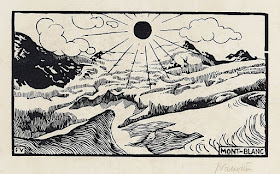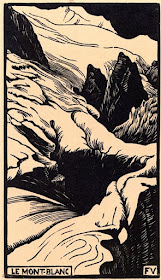JAMES NASMYTH (1808-1890)
Mons Pico (2,450m - 8,038ft)
The Moon
1 In Pico as seen by a spectator in the moon, early photography, circa 1860 by James Nasmyth
2. In Mons Pico (left) and Mons Pico Beta (right), Mare Imbrium, 1971,
NASA APOLLO 15 MISSION (July, 26, 1971- August 7, 1971)
The mountain
Mons Pico (2,450m - 8,038ft) is a solitary lunar mountain that lies in the northern part of the Mare Imbrium basin, to the south of the dark-floored crater Plato and on the southern rim of a ghost crater. This peak forms part of the surviving inner ring of the Imbrium basin, continuing to the northwest and with the Montes Teneriffe and Montes Recti ranges, and probably to the southeast with the Montes Spitzbergen. This mountain feature was most likely named by Schröter for the Pico von Teneriffe (Teide). The selenographic coordinates of this peak are 45.7° N, 8.9° W. It forms an elongated feature with a length of 25 kilometers (oriented northwest-southeast) and a width of 15 km. The mountain itself is a very reflective and bright object. The exact elevation of the mountain was recently measured by the Lunar Reconnaissance Orbiter on October 1, 2016.
Due to its isolated location on the lunar mare, however, this peak can form prominent shadows when illuminated by oblique sunlight. It is also known as a location of Transient Lunar Anomalies. A smaller peak to the southeast of Mons Pico is sometimes called Mons Pico β (Beta), although this does not appear to be recognized by the IAU. This region of the mare is notable for a number of wrinkle ridges.
The artist
James Hall Nasmyth (sometimes spelled Naesmyth, Nasmith, or Nesmyth) was a Scottish engineer, artist and inventor famous for his development of the steam hammer. He was the co-founder of Nasmyth, Gaskell and Company manufacturers of machine tools. He retired at the age of 48, and moved to Penshurst, Kent where he developed his hobbies of astronomy and photography.
Nasmyth retired from business in 1856 as he said "I have now enough of this world's goods: let younger men have their chance". He renamed his retirement home "Hammerfield" and happily pursued his various hobbies. He built his own 20-inch reflecting telescope, in the process inventing the Nasmyth focus, and made detailed observations of the Moon. He co-wrote The Moon : Considered as a Planet, a World, and a Satellite with James Carpenter (1840–1899). This book contains an interesting series of "lunar" photographs: because photography was not yet advanced enough to take actual pictures of the Moon, Nasmyth built plaster models based on his visual observations of the Moon and then photographed the models. A crater on the Moon is named after him. In memory of his renowned contribution to the discipline of mechanical engineering, the Department of Mechanical Engineering building at Heriot-Watt University, in his birthplace of Edinburgh, is called the James Nasmyth Building.
The mission
NASA APOLLO 15 MISSION (July, 26, 1971- August 7, 1971)
Apollo 15 was the ninth manned mission in the United States' Apollo program, the fourth to land on the Moon, and the eighth successful manned mission. It was the first of what were termed
"J missions", long stays on the Moon, with a greater focus on science than had been possible on previous missions. It was also the first mission on which the Lunar Roving Vehicle was used.
The mission began on July 26, 1971, and ended on August 7. At the time, NASA called it the most successful manned flight ever achieved.
Commander David Scott and Lunar Module Pilot James Irwin spent three days on the Moon, including 18Ѕ hours outside the spacecraft on lunar extra-vehicular activity (EVA). The mission landed near Hadley rille, in an area of the Mare Imbrium called Palus Putredinus (Marsh of Decay). The crew explored the area using the first lunar rover, which allowed them to travel much farther from the Lunar Module (LM) than had been possible on missions without the rover. They collected 77 kilograms (170 lb) of lunar surface material. At the same time, Command Module Pilot Alfred Worden orbited the Moon, using a Scientific Instrument Module (SIM) in the Service Module (SM) to study the lunar surface and environment in great detail with a panoramic camera, a gamma-ray spectrometer, a mapping camera, a laser altimeter, a mass spectrometer, and a lunar sub-satellite deployed at the end of Apollo 15's stay in lunar orbit (an Apollo program first).
The mission successfully accomplished its objectives. Ironically, this mission was one of very few that had been honored with the issue of a commemorative US stamp, with this first use of a lunar rover happening one decade after the first Mercury astronaut launch.


















